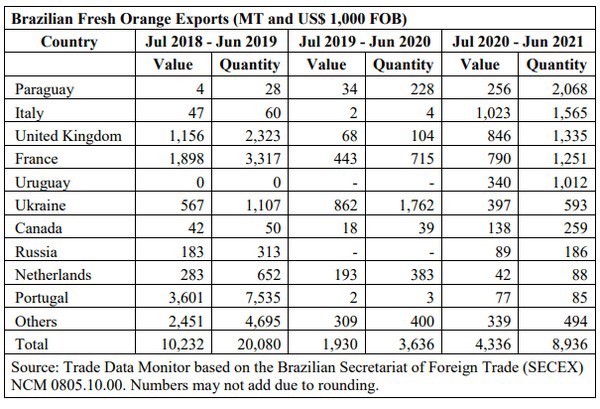The Brazilian orange crop for Marketing Year 2021/22 is forecast at 405 million 40.8-kg boxes (MBx), equal to 16.52 million metric tons (MMT), an increase of 12 percent relative to the current season. The forecast assumes normal weather conditions will prevail as of mid-December 2021 to support fruit setting and development of the second blossoming in the Sao Paulo and Minas Gerais commercial citrus belt.
The current orange crop estimate in the Sao Paulo and Minas Gerais citrus belt was revised downward from 294.2 to 264 MBx (12 MMT to 10.77 MMT) as a consequence of adverse weather conditions including a severe drought and successive frosts. Total Brazilian FCOJ 65 Brix equivalent exports for MY 2021/22 are forecast at 1 MMT, similar to revised figure for MY 2020/21.
Exports
Total fresh orange exports for MY 2021/22 are projected at 0.2 MBx (8,160 MT), an increase of 0.1 MB compared to fresh orange export estimate for MY 2020/21 (0.1 MBx or 4,100 MT), according to updated information from the Brazilian Secretariat of Foreign Trade (Secex). Paraguay, Italy, U.K., France and Uruguay were the major export destinations for fresh orange exports during the July-2020 – June 2021 period.

The table above shows fresh orange exports (NCM 0805.10.00) by destination, according to the Trade Data Monitor (TDM), based on data from the Secretariat of Foreign Trade (Secex) for BR MY 2018/19, 2019/20 and 2020/21 (July-June), as well as for BR 2019/20, 2020/21 and 2021/22 (July-November).
Click here to read the full report.
Source: apps.fas.usda.gov
